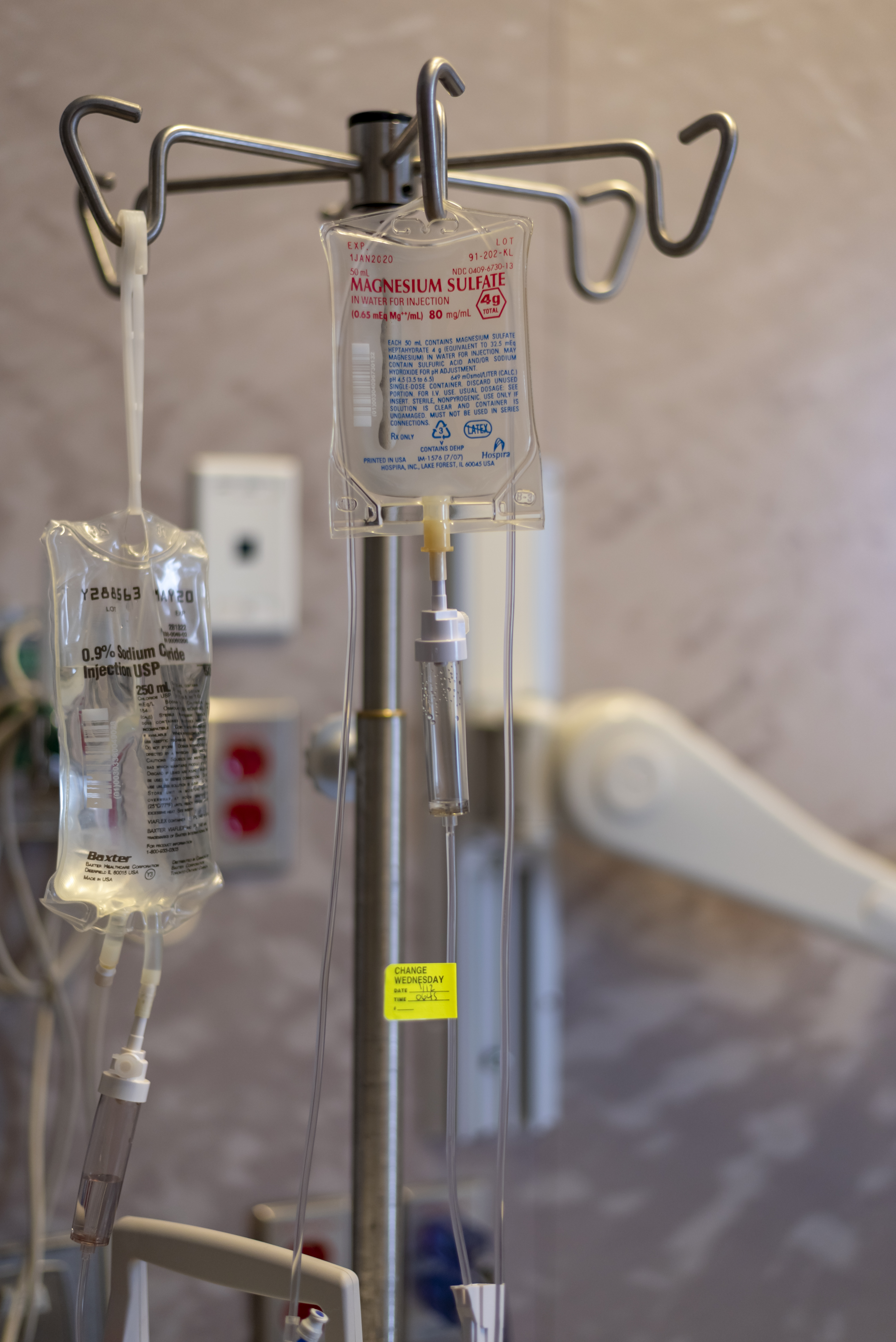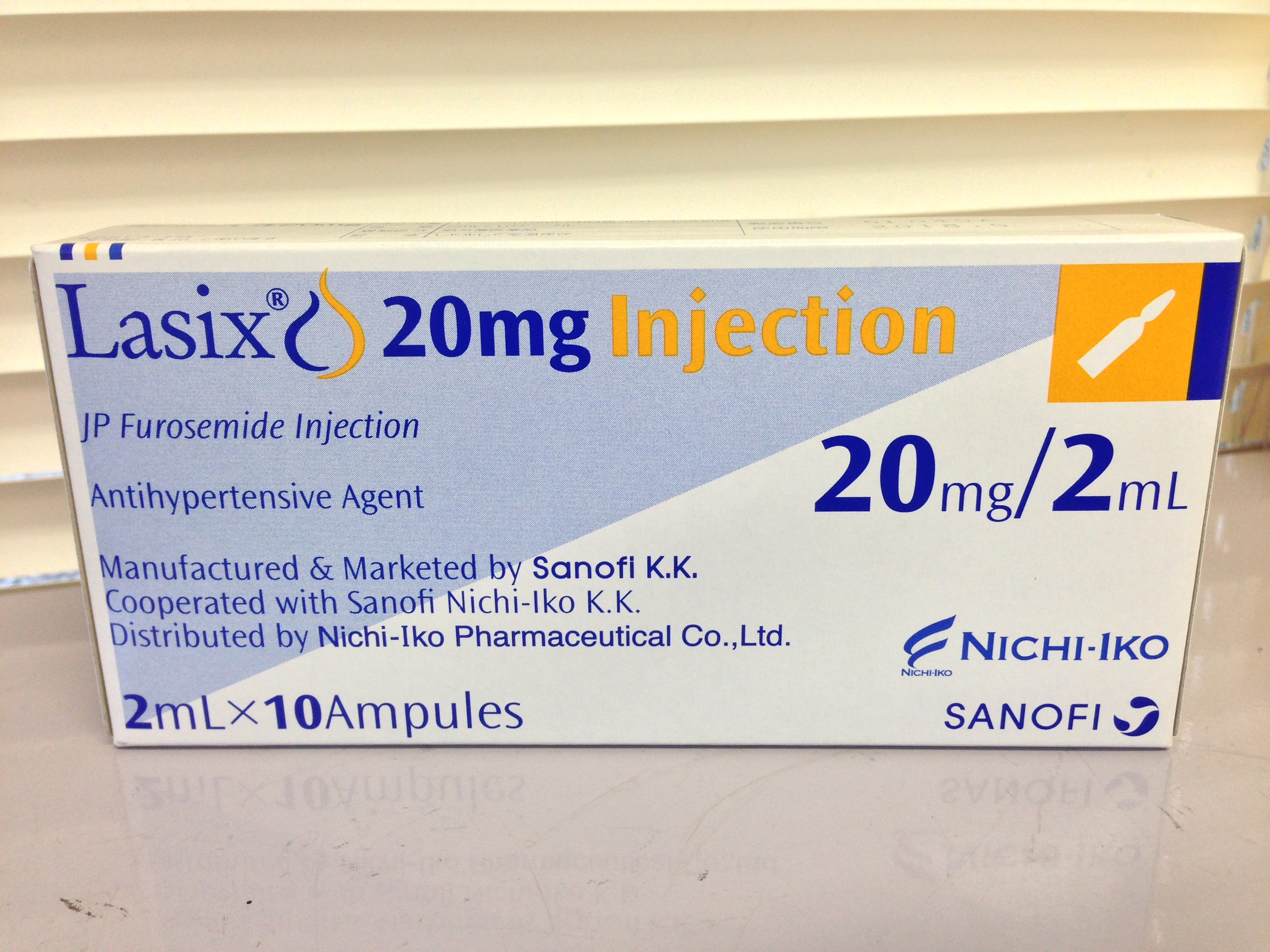|
Magnesium Deficiency
Magnesium deficiency is an electrolyte disturbance in which there is a low level of magnesium in the body. Symptoms include tremor, poor coordination, muscle spasms, loss of appetite, personality changes, and nystagmus. Complications may include seizures or cardiac arrest such as from torsade de pointes. Those with low magnesium often have low potassium. Causes include low dietary intake, alcoholism, diarrhea, increased urinary loss, and poor absorption from the intestines. Some medications may also cause low magnesium, including proton pump inhibitors (PPIs) and furosemide. The diagnosis is typically based on finding low blood magnesium levels, also called hypomagnesemia. Normal magnesium levels are between 0.6 and 1.1 mmol/L (1.46–2.68 mg/dL) with levels less than 0.6 mmol/L (1.46 mg/dL) defining hypomagnesemia. Specific electrocardiogram (ECG) changes may be seen. Treatment is with magnesium either by mouth or intravenously. For those with severe s ... [...More Info...] [...Related Items...] OR: [Wikipedia] [Google] [Baidu] |
Magnesium
Magnesium is a chemical element; it has Symbol (chemistry), symbol Mg and atomic number 12. It is a shiny gray metal having a low density, low melting point and high chemical reactivity. Like the other alkaline earth metals (group 2 of the periodic table), it occurs naturally only in combination with other elements and almost always has an oxidation state of +2. It reacts readily with air to form a thin Passivation (chemistry), passivation coating of magnesium oxide that inhibits further corrosion of the metal. The free metal burns with a brilliant-white light. The metal is obtained mainly by electrolysis of magnesium Salt (chemistry), salts obtained from brine. It is less dense than aluminium and is used primarily as a component in strong and lightweight magnesium alloy, alloys that contain aluminium. In the cosmos, magnesium is produced in large, aging stars by the sequential addition of three Helium nucleus, helium nuclei to a carbon nucleus. When such stars explo ... [...More Info...] [...Related Items...] OR: [Wikipedia] [Google] [Baidu] |
Loss Of Appetite
Anorexia is a medical term for a loss of appetite. While the term outside of the scientific literature is often used interchangeably with anorexia nervosa, many possible causes exist for a loss of appetite, some of which may be harmless, while others indicate a serious clinical condition or pose a significant risk. Anorexia is a symptom, not a diagnosis. The symptom also occurs in non-human animals, such as cats, dogs, cattle, goats, and sheep. In these species, anorexia may be referred to as inappetence. As in humans, loss of appetite can be due to a range of diseases and conditions, as well as environmental and psychological factors. Etymology The term is from (, 'without' + , spelled , meaning 'appetite'). Common manifestations Anorexia simply manifests as a decreased or loss of appetite. This can present as not feeling hungry or lacking the desire to eat. Sometimes people do not even notice they lack an appetite until they begin to lose weight from eating less. In oth ... [...More Info...] [...Related Items...] OR: [Wikipedia] [Google] [Baidu] |
Paresthesia
Paresthesia is a sensation of the skin that may feel like numbness (''hypoesthesia''), tingling, pricking, chilling, or burning. It can be temporary or Chronic condition, chronic and has many possible underlying causes. Paresthesia is usually painless and can occur anywhere on the body, but most commonly in the arms and legs. The most familiar kind of paresthesia is the sensation known as ''pins and needles'' after having a limb "fall asleep" (''obdormition''). A less common kind is formication, the sensation of insects crawling on the skin. Causes Transient Paresthesias of the hands, feet, legs, and arms are common transient symptoms. The briefest electric shock type of paresthesia can be caused by tweaking the ulnar nerve near the elbow; this phenomenon is colloquially known as bumping one's "funny bone". Similar brief shocks can be experienced when any other nerve is tweaked (e.g. a pinched neck nerve may cause a brief shock-like paresthesia toward the scalp). In the older a ... [...More Info...] [...Related Items...] OR: [Wikipedia] [Google] [Baidu] |
Nervous System
In biology, the nervous system is the complex system, highly complex part of an animal that coordinates its behavior, actions and sense, sensory information by transmitting action potential, signals to and from different parts of its body. The nervous system detects environmental changes that impact the body, then works in tandem with the endocrine system to respond to such events. Nervous tissue first arose in Ediacara biota, wormlike organisms about 550 to 600 million years ago. In Vertebrate, vertebrates, it consists of two main parts, the central nervous system (CNS) and the peripheral nervous system (PNS). The CNS consists of the brain and spinal cord. The PNS consists mainly of nerves, which are enclosed bundles of the long fibers, or axons, that connect the CNS to every other part of the body. Nerves that transmit signals from the brain are called motor nerves (efferent), while those nerves that transmit information from the body to the CNS are called sensory nerves (aff ... [...More Info...] [...Related Items...] OR: [Wikipedia] [Google] [Baidu] |
Cardiac Arrhythmia
Arrhythmias, also known as cardiac arrhythmias, are irregularities in the heartbeat, including when it is too fast or too slow. Essentially, this is anything but normal sinus rhythm. A resting heart rate that is too fast – above 100 beats per minute in adults – is called tachycardia, and a resting heart rate that is too slow – below 60 beats per minute – is called bradycardia. Some types of arrhythmias have no symptoms. Symptoms, when present, may include palpitations or feeling a pause between heartbeats. In more serious cases, there may be lightheadedness, passing out, shortness of breath, chest pain, or decreased level of consciousness. While most cases of arrhythmia are not serious, some predispose a person to complications such as stroke or heart failure. Others may result in sudden death. Arrhythmias are often categorized into four groups: extra beats, supraventricular tachycardias, ventricular arrhythmias and bradyarrhythmias. Extra beats incl ... [...More Info...] [...Related Items...] OR: [Wikipedia] [Google] [Baidu] |
Cramp
A cramp is a sudden, involuntary, painful skeletal muscle contraction or overshortening associated with electrical activity. While generally temporary and non-damaging, they can cause significant pain and a paralysis-like immobility of the affected muscle. A cramp usually goes away on its own over several seconds or (sometimes) minutes. Cramps are common and tend to occur at rest, usually at night (nocturnal leg cramps). They are also often associated with pregnancy, physical exercise or overexertion, and age (common in older adults); in such cases, cramps are called idiopathic because there is no underlying pathology. In addition to those benign conditions cramps are also associated with many pathological conditions. Cramp definition is narrower than the definition of muscle spasm: spasms include any involuntary abnormal muscle contractions, while cramps are sustained and painful. True cramps can be distinguished from other cramp-like conditions. Cramps are different from mus ... [...More Info...] [...Related Items...] OR: [Wikipedia] [Google] [Baidu] |
Tiredness
Fatigue is a state of tiredness (which is not sleepiness), exhaustion or loss of energy. It is a symptom of any of various diseases; it is not a disease in itself. Fatigue (in the medical sense) is sometimes associated with medical conditions including autoimmune disease, organ failure, chronic pain conditions, mood disorders, heart disease, infectious diseases, and post-infectious-disease states. However, fatigue is complex and in up to a third of primary care cases no medical or psychiatric diagnosis is found. Fatigue (in the general usage sense of normal tiredness) often follows prolonged physical or mental activity. Physical fatigue results from muscle fatigue brought about by intense physical activity. Mental fatigue results from prolonged periods of cognitive activity which impairs cognitive ability, can manifest as sleepiness, lethargy, or directed attention fatigue, and can also impair physical performance. Definition Fatigue in a medical context is used to cover ex ... [...More Info...] [...Related Items...] OR: [Wikipedia] [Google] [Baidu] |
Hypomagnesemia
Magnesium deficiency is an electrolyte disturbance in which there is a low level of magnesium in the body. Symptoms include tremor, poor coordination, muscle spasms, loss of appetite, personality changes, and nystagmus. Complications may include seizures or cardiac arrest such as from torsade de pointes. Those with low magnesium often have low potassium. Causes include low dietary intake, alcoholism, diarrhea, increased urinary loss, and poor absorption from the intestines. Some medications may also cause low magnesium, including proton pump inhibitors (PPIs) and furosemide. The diagnosis is typically based on finding low blood magnesium levels, also called hypomagnesemia. Normal magnesium levels are between 0.6 and 1.1 mmol/L (1.46–2.68 mg/dL) with levels less than 0.6 mmol/L (1.46 mg/dL) defining hypomagnesemia. Specific electrocardiogram (ECG) changes may be seen. Treatment is with magnesium either by mouth or intravenously. For those with sev ... [...More Info...] [...Related Items...] OR: [Wikipedia] [Google] [Baidu] |
Low Calcium
Hypocalcemia is a medical condition characterized by low calcium levels in the blood serum. The normal range of blood calcium is typically between 2.1–2.6 mmol/L (8.8–10.7 mg/dL, 4.3–5.2 mEq/L), while levels less than 2.1 mmol/L are defined as hypocalcemic. Mildly low levels that develop slowly often have no symptoms. Otherwise symptoms may include numbness, muscle spasms, seizures, confusion, or in extreme cases cardiac arrest. The most common cause for hypocalcemia is iatrogenic hypoparathyroidism. Other causes include other forms of hypoparathyroidism, vitamin D deficiency, kidney failure, pancreatitis, calcium channel blocker overdose, rhabdomyolysis, tumor lysis syndrome, and medications such as bisphosphonates or denosumab. Diagnosis should generally be confirmed by determining the corrected calcium or ionized calcium level. Specific changes may also be seen on an electrocardiogram (ECG). Initial treatment for severe disease is with intravenous ... [...More Info...] [...Related Items...] OR: [Wikipedia] [Google] [Baidu] |
Magnesium Sulfate (medical Use)
Magnesium sulfate as a medication is used to treat and prevent low blood magnesium and seizures in women with eclampsia. It is also used in the treatment of torsades de pointes, severe asthma exacerbations, constipation, and barium poisoning. It is given by intravenous, injection into a vein or intramuscular injection, muscle as well as by mouth. As epsom salts, it is also used for mineral baths. Common side effects include low blood pressure, skin flushing, and low blood calcium. Other side effects may include vomiting, muscle weakness, and decreased breathing. While there is evidence that use during pregnancy may harm the baby, the benefits in certain conditions are greater than the risks. Its use during breastfeeding is deemed to be safe. The way it works is not fully understood, but is believed to involve depressing the action of neurons. Magnesium sulfate came into medical use at least as early as 1618. It is on the WHO Model List of Essential Medicines, World Health O ... [...More Info...] [...Related Items...] OR: [Wikipedia] [Google] [Baidu] |
Furosemide
Furosemide, sold under the brand name Lasix among others, is a loop diuretic medication used to treat edema due to heart failure, liver scarring, or kidney disease. Furosemide may also be used for the treatment of high blood pressure. It can be taken intravenously or orally. When given intravenously, furosemide typically takes effect within five minutes; when taken orally, it typically metabolizes within an hour. Common side effects include orthostatic hypotension (decrease in blood pressure while standing, and associated lightheadedness), tinnitus (ringing in the ears), and photosensitivity (sensitivity to light). Potentially serious side effects include electrolyte abnormalities, low blood pressure, and hearing loss. It is recommended that serum electrolytes (especially potassium), serum , creatinine, BUN levels, and liver and kidney functioning be monitored in patients taking furosemide. It is also recommended to be alert for the occurrence of any potential blood d ... [...More Info...] [...Related Items...] OR: [Wikipedia] [Google] [Baidu] |




